Research on Selection and Matching of Truck-Shovel in Oversized Open-Pit Mines
Abstract
:1. Introduction
2. Selection and Matching of Shovels
2.1. Production Capacity Calculation of Shovels
2.2. Analysis of Reasonable Number of Shovels
2.3. Determination of Shovel’s Bucket Capacity
3. Selection and Matching of Trucks
3.1. Efficiency Model of Truck-Shovel and Determination of Bucket-To-Capacity Ratio
3.2. Calculation of Truck Quantity
4. Software System of Truck-Shovel Matching
5. Conclusions
- (1)
- The reasonable number of shovels for an oversized open-pit mine should be 4~7, and the shovel should be more than 15 m3. When the annual excavation volume is 80~150 million tons, the 35~55 m3 shovels should be the main configuration specifications. When the total annual excavation volume is more than 150 million tons, the 55 m3 shovel can be considered, but at the same time, it should be determined comprehensively in consideration of mining conditions, ore blending flexibility and equipment application maturity.
- (2)
- Using the truck-shovel efficiency model to determine the optimum bucket-to-capacity ratio is suitable. When the bucket-to-capacity ratio is 4~5:1 in the oversize open-pit mine, the overall economy is better. The 35 m3 shovel is suitable for matching 220~270 t trucks, the 45 m3 shovel is suitable for matching 270~330 t trucks and the 55m3 shovel is suitable for matching 330~400 t trucks.
- (3)
- The software system of truck-shovel matching is developed by using C# language under the NET framework. Users can automatically select the equipment and calculate the equipment quantity. Meanwhile, multiple equipment matching schemes can be generated, and the economic comparison of equipment can be automatically completed. It also supports the calculation of material consumption for the recommended device solution and automatically outputs the material consumption report of the device.
Author Contributions
Funding
Institutional Review Board Statement
Informed Consent Statement
Data Availability Statement
Conflicts of Interest
References
- Miao, M.-Y. Truck-shovel selection and calculation of automobile transport scheme in open-pit mine design. Eng. Des. Res. 1996, 4, 14–18. [Google Scholar]
- Wang, Z.-Q. Selection and matching of truck and excavator in open-pit mine loading operation. Non-Met. Mines 2002, 25, 41–42. [Google Scholar]
- Wang, J.-D. Selection of mining and transport equipment in open-pit mine. Opencast Min. Technol. 2017, 32, 30–33. [Google Scholar]
- Yin, W.-Y.; Zhou, W.; Peng, X.-Q.; Li, J.; Zhu, Y. Analysis on selection of open pit mine transport equipment based on VPRS and VIKOR method. Coal Technol. 2016, 35, 243–245. [Google Scholar]
- Liu, S.-X.; Li, B.; Zhang, X.-H.; Fu, X.; Lu, S. The application of AHP-FUZZY in equipment selection of open-pit mine (P). Min. Res. Dev. 2017, 37, 98–100. [Google Scholar]
- Wang, H. Analysis of process equipment selection and matching in open pit mine. J. Shandong Ind. Technol. 2016, 8, 69. [Google Scholar]
- Chang, Z.-G.; Chen, Y.-J.; Mao, J.-F. Research of reasonable matching of shovel-truck technology in open pit mine. Coal Mine Mach. 2015, 36, 74–76. [Google Scholar]
- Xiao, G.-Q. Methods Research and Application of Shovel Selection and Truck Matching Combination for Surface Coal Mine Shovel-Truck System. Ph.D Thesis, China University of Mining & Technology, Wudaokou, China, 2014. [Google Scholar]
- Luo, Z.-Y. Study on loading and transporting system in open pits. Q. CIMR 1991, 4, 23–28. [Google Scholar]
- Bakhtavar, E.; Mahmoudi, H. Development of a scenario-based robust model for the best truck-shovel allocation in open-pit mining. Comput. Oper. Res. 2020, 115, 104539. [Google Scholar] [CrossRef]
- Ercelebi S, G. Optimization of shovel-truck system for surface mining. Template J. 2009, 109, 433–439. [Google Scholar]
- Rai, P. Optimising shovel-truck combination. Coal Int. Min. Quarry World 2000, 248, 230–231. [Google Scholar]
- He, M.-X.; Wei, J.-C.; Lu, X.-M. The genetic algorithm for truck dispatching problems in surface mine. Inf. Technol. J. 2010, 9, 710–714. [Google Scholar]
- Oraee, K.; Asi, B. Fuzzy Model for Truck Allocation in SURFACE MINES. In Proceedings of the 13th International Symposium on Mine Planning and Equipment Selection (MPES), Wroclaw, Poland, 1–3 September 2004; pp. 585–591. [Google Scholar]
- Upadhyay, S.P.; Askari-Nasab, H. Truck-shovel allocation optimisation: A goal programming approach. Min. Technol. 2016, 125, 82–92. [Google Scholar] [CrossRef]
- Nageshwaraniyer, S.S.; Son, Y.J.; Dessureault, S. Simulation-based robust optimization for complex truck-shovel systems in surface coal mines. In Proceedings of the 2013 Winter Simulations Conference (WSC), Washington, DC, USA, 8–11 December 2013. [Google Scholar]
- Rodrigo, M.; Enrico, Z. Availability-based simulation and optimization modeling framework for open-pit mine truck allocation under dynamic constraints. Int. J. Min. Sci. Technol. 2013, 23, 113–119. [Google Scholar]
- Wang, Y.-M. Manual of China Mining Equipment; Science Press: Beijing, China, 2007. [Google Scholar]
- Metalica. Life of Mine Plan and Ore Reserves Estimate for the TOROMOCHO Mine; Tetra Tech: Chinalco, Peru, 2018. [Google Scholar]
- Zhang, Y.-D. Open-Pit Mining System Engineering; China Coal Industry Publishing House: Beijing, China, 1989; pp. 75–80. [Google Scholar]
- Wu, F.-R.; He, J.-L. Optimization of mining equipment selection in oversize polymetallic open-pit mine. Min. Equip. 2012, 8, 102–103. [Google Scholar]
- Cao, Z.-Q. Study on transport system optimization of Gulianhe open-pit coal mine. New Technol. New Prod. China 2012, 9, 168. [Google Scholar]
- Gao, T.-P. Research on truck-shovel system efficiency based on bucket-to-capacity ratio in open-pit mine. Opencast Min. Technol. 2015, 6, 51–54. [Google Scholar]
- Zhang, D.; Luo, H.-T.; Xu, C.; Qin, T. Research on matching optimization of truck-shovel in Harwusu open-pit coal mine. Opencast Min. Technol. 2012, S2, 37–40, 43. [Google Scholar]
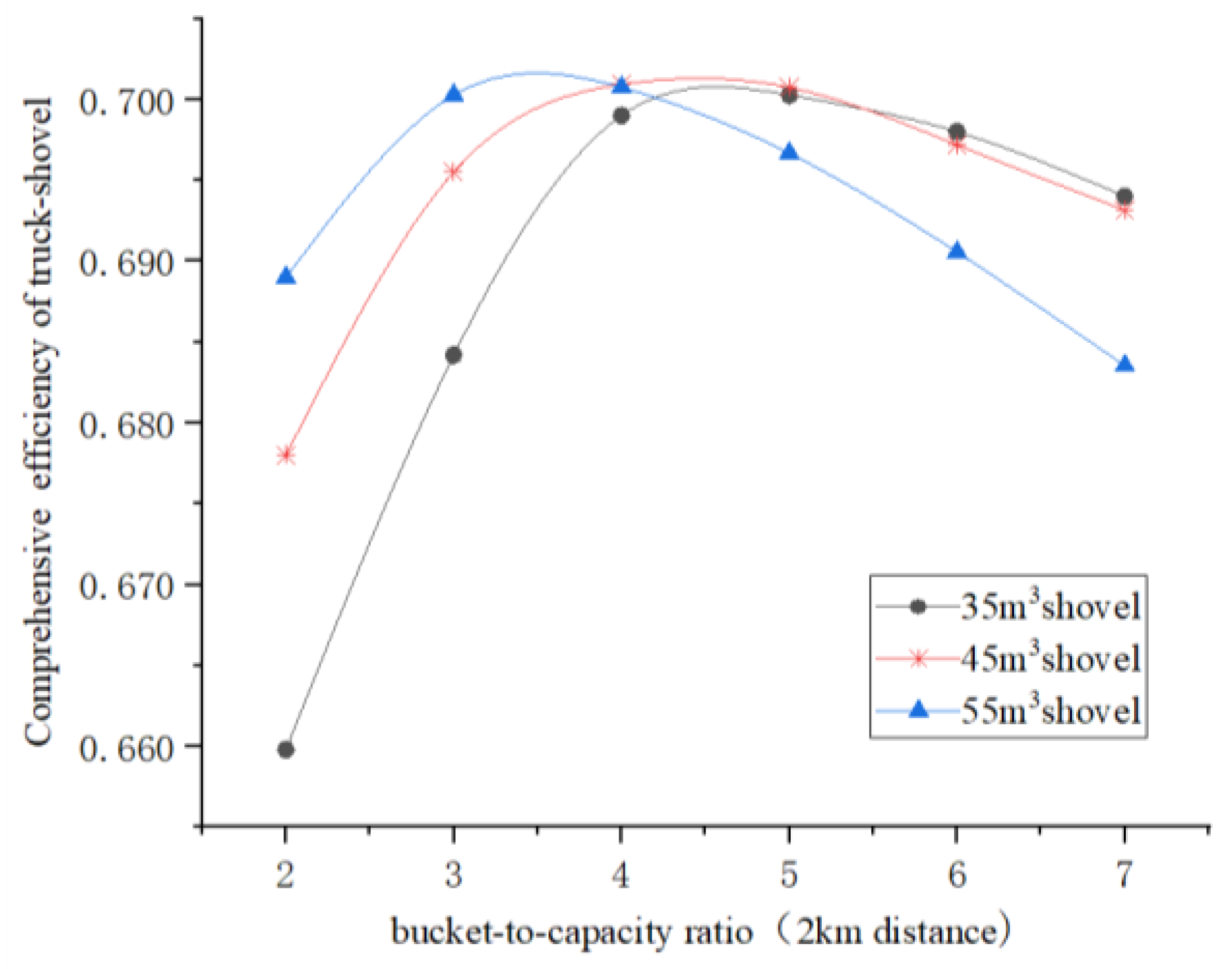
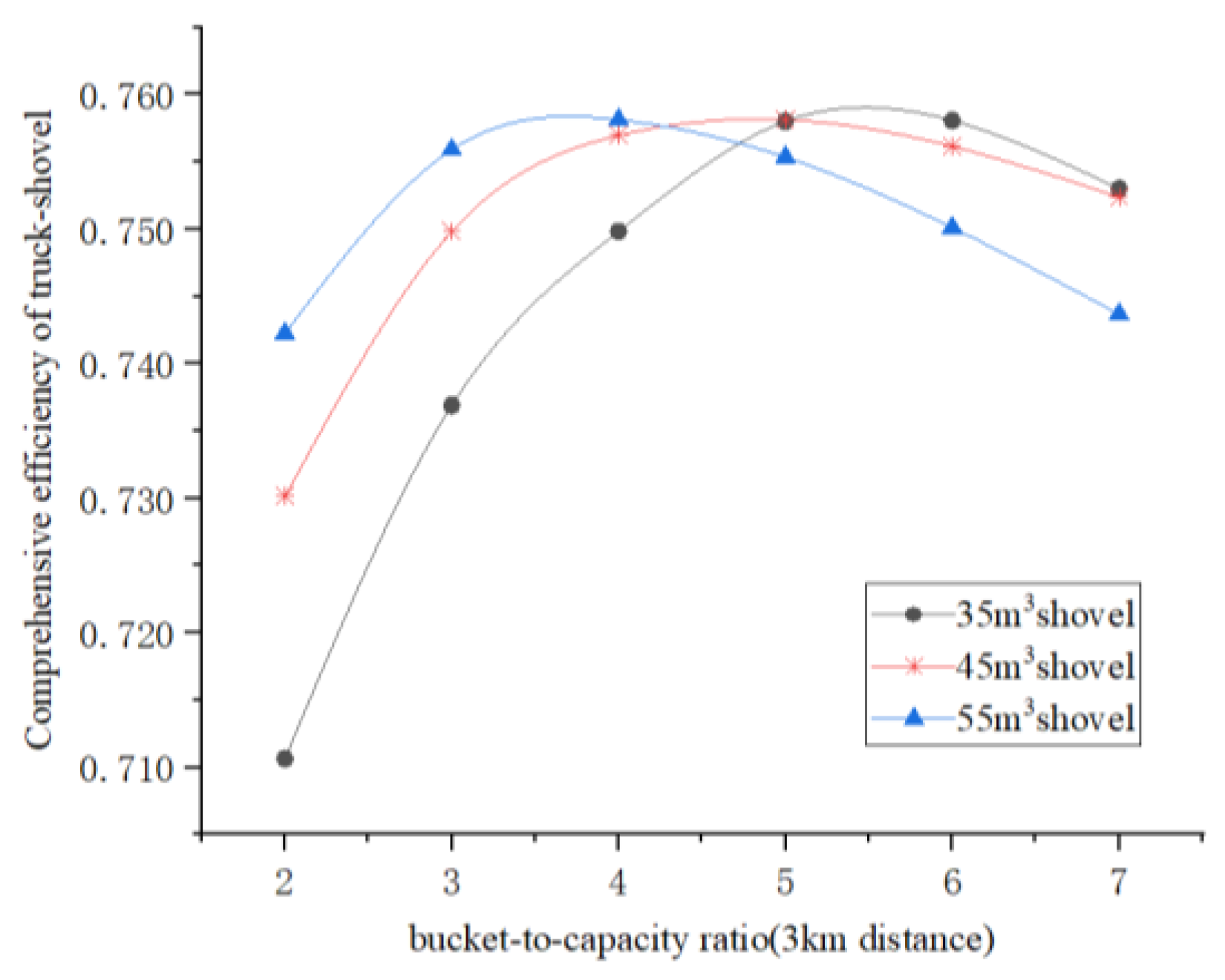
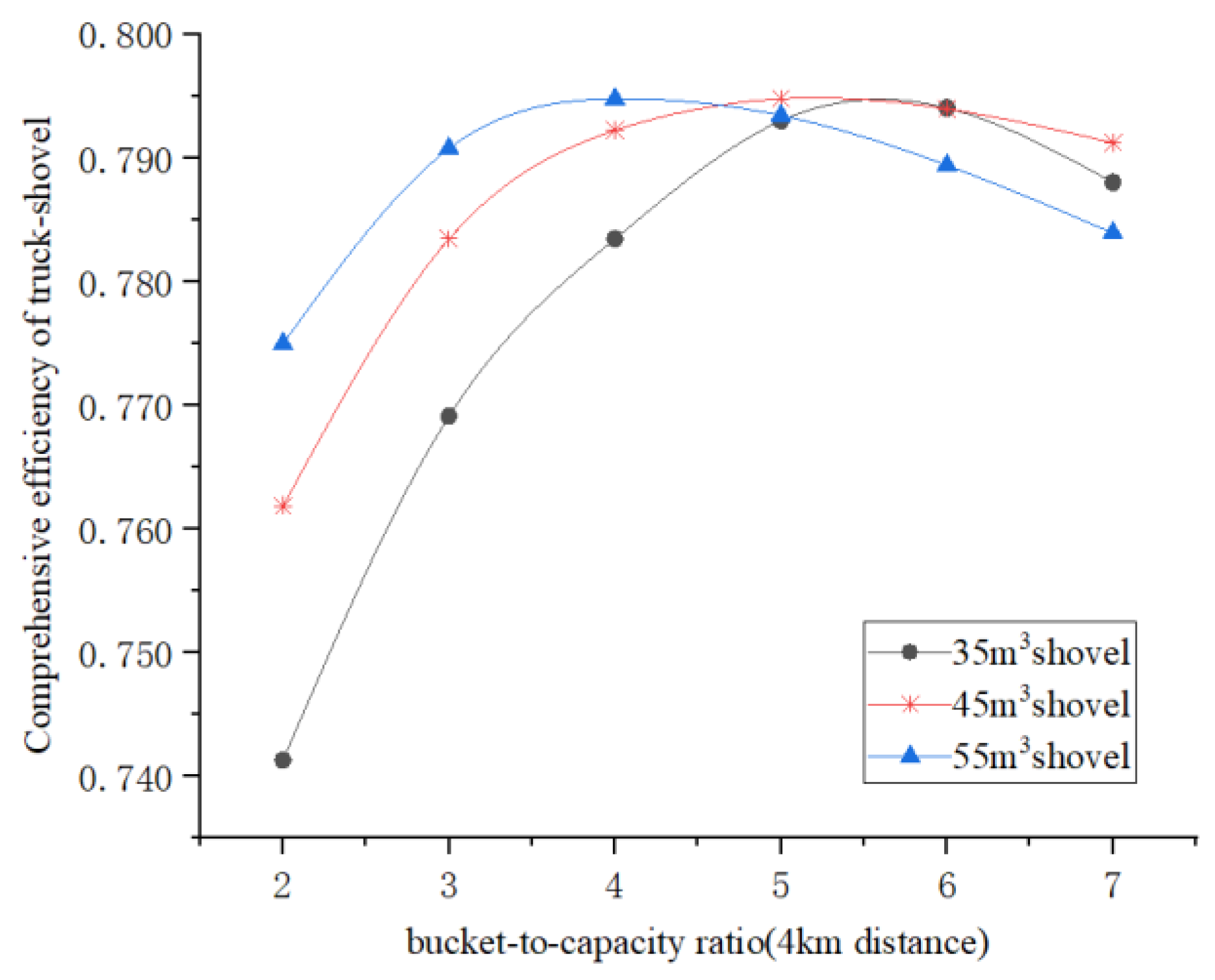
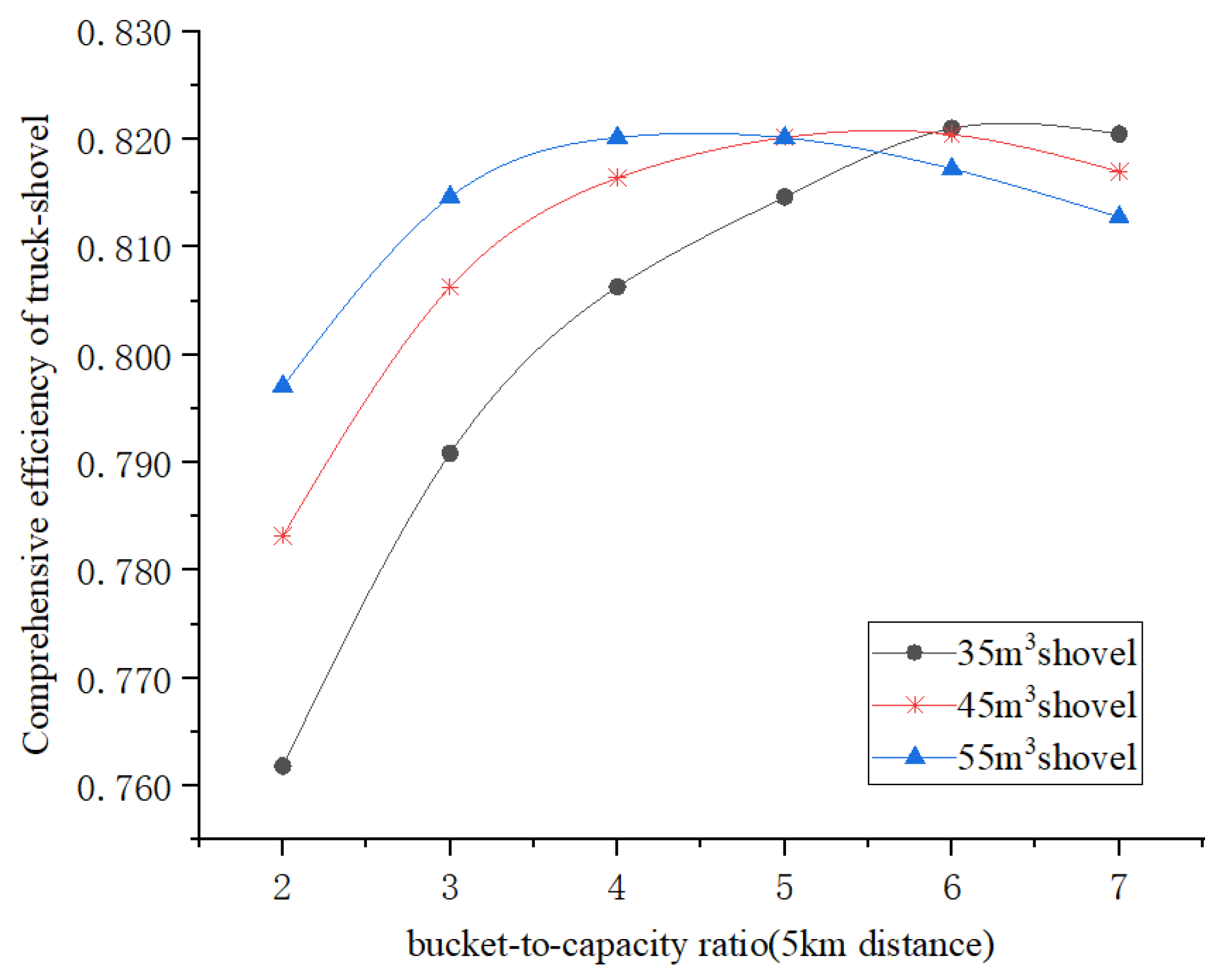
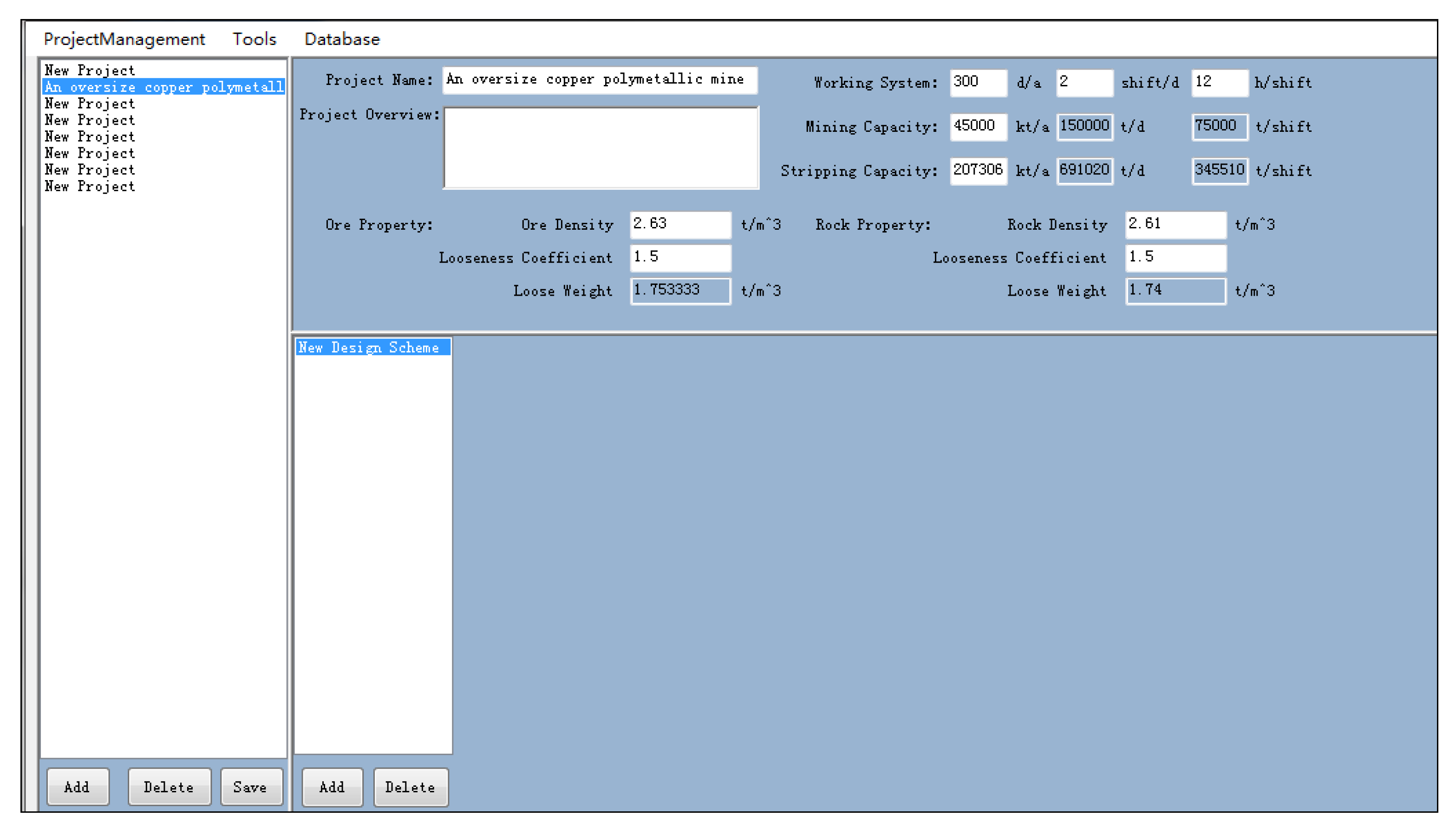

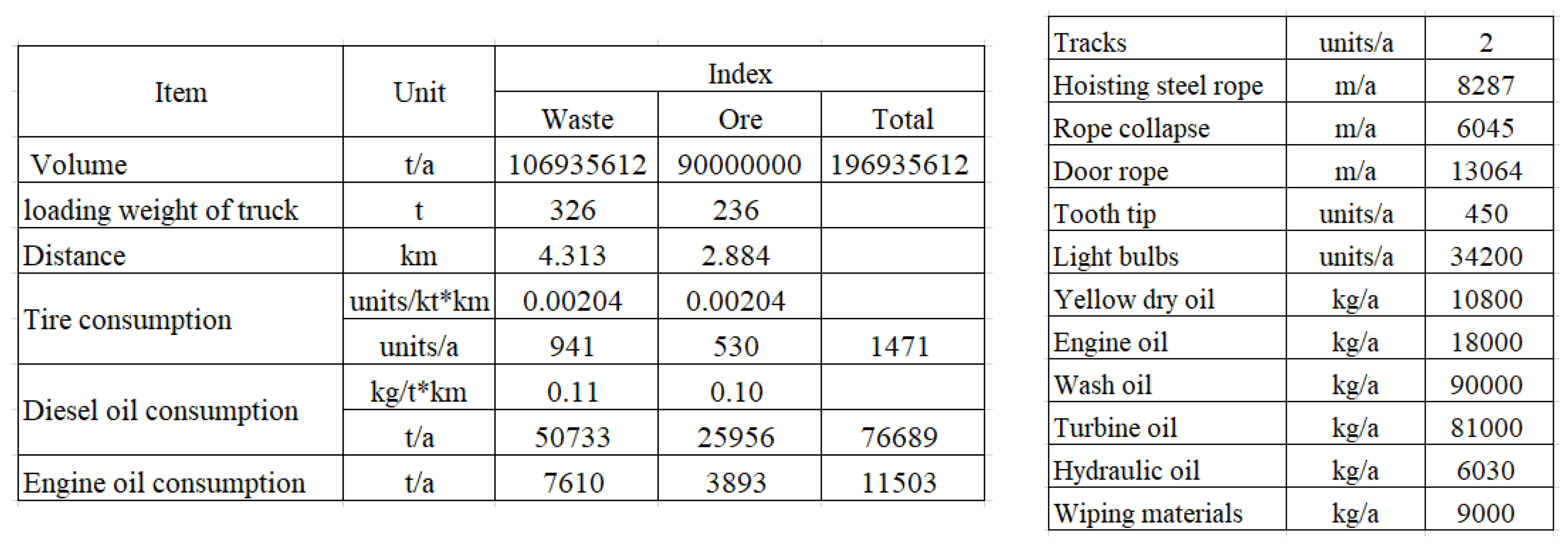
| Item | 2015 | 2016 | 2017 | ||||||||||
|---|---|---|---|---|---|---|---|---|---|---|---|---|---|
| Average | Average | January | February | March | April | May | June | July | August | September | October | ||
| shovel | attendance rate/% | 91.8 | 89.2 | 93.1 | 88.4 | 91.2 | 86.6 | 88.7 | 76.0 | 76.0 | 90.9 | 85.7 | 90.8 |
| utilization rate/% | 87.7 | 78.5 | 76.1 | 77.6 | 80.4 | 78.1 | 82.3 | 84.1 | 84.1 | 82.8 | 81.5 | 78.5 | |
| truck | attendance rate/% | 87.2 | 82.4 | 79.8 | 74.3 | 73.1 | 70.9 | 76.8 | 83.5 | 83.5 | 86.6 | 83.5 | 86.6 |
| utilization rate/% | 83.0 | 80.5 | 77.8 | 78.0 | 80.0 | 81.9 | 83.0 | 80.2 | 80.2 | 79.3 | 77.8 | 74.2 | |
| Item | 2017 | 2018 | |||||||||||
| November | December | January | February | March | April | May | June | July | August | September | |||
| shovel | attendance rate/% | 88.4 | 91.3 | 92.6 | 82.1 | 86.0 | 88.4 | 85.0 | 88.4 | 76.1 | 91.9 | 87.8 | |
| utilization rate/% | 81.8 | 82.0 | 81.6 | 81.5 | 81.9 | 82.1 | 84.0 | 85.9 | 84.6 | 83.5 | 83.0 | ||
| truck | attendance rate/% | 81.9 | 78.6 | 76.2 | 72.4 | 72.0 | 76.1 | 76.9 | 79.9 | 75.5 | 75.5 | 79.4 | |
| utilization rate/% | 78.8 | 79.6 | 78.1 | 79.4 | 79.7 | 78.1 | 81.0 | 82.0 | 83.1 | 79.8 | 77.9 | ||
| Probability | The Number of Registered Shovels | ||||||||
|---|---|---|---|---|---|---|---|---|---|
| 1 | 2 | 3 | 4 | 5 | 6 | 7 | 8 | ||
| the actual number of shovels in attendance | 0 | 0.11 | 0.0121 | 0.001331 | 0.000146 | 0.000016 | 0.0000018 | 0.000000195 | 0.000000021 |
| 1 | 0.89 | 0.1958 | 0.032307 | 0.004738 | 0.000652 | 0.0000860 | 0.000011037 | 0.000001387 | |
| 2 | 0.7921 | 0.261393 | 0.057506 | 0.010543 | 0.0017396 | 0.000267894 | 0.000039291 | ||
| 3 | 0.704969 | 0.310186 | 0.085301 | 0.0187663 | 0.003612508 | 0.000635801 | |||
| 4 | 0.627422 | 0.345082 | 0.1138772 | 0.029228473 | 0.006430264 | ||||
| 5 | 0.558406 | 0.3685479 | 0.141890951 | 0.041621346 | |||||
| 6 | 0.4969813 | 0.382675594 | 0.168377261 | ||||||
| 7 | 0.442313349 | 0.389235747 | |||||||
| 8 | 0.393658881 | ||||||||
| ≥3 | 0.704969 | 0.937608 | 0.988789 | 0.9981727 | 0.999720875 | 0.9999593 | |||
| Excavation Scales (104 t/a) | Bucket Capacity Configuration under Different Number of Shovels (m3) | |||
|---|---|---|---|---|
| 4 | 5 | 6 | 7 | |
| 6000 | 26 | 21 | 18 | 15 |
| 7000 | 31 | 25 | 20 | 18 |
| 8000 | 35 | 28 | 23 | 20 |
| 9000 | 39 | 32 | 26 | 23 |
| 10,000 | 44 | 35 | 29 | 25 |
| 11,000 | 48 | 39 | 32 | 28 |
| 12,000 | 53 | 42 | 35 | 30 |
| 13,000 | 57 | 46 | 38 | 33 |
| 14,000 | 61 | 49 | 41 | 35 |
| 15,000 | 66 | 53 | 44 | 38 |
| 16,000 | 70 | 56 | 47 | 40 |
| 17,000 | 74 | 60 | 50 | 43 |
| 18,000 | 79 | 63 | 53 | 45 |
| 19,000 | 83 | 67 | 55 | 48 |
| 20,000 | 88 | 70 | 58 | 50 |
| Shovel Specifications | Truck Loading Weight | Bucket-To-Capacity Ratio |
|---|---|---|
| 35 m3 | 220~270 t | 4~5 |
| 45 m3 | 270~330 t | 4~5 |
| 55 m3 | 330~400 t | 4~5 |
Disclaimer/Publisher’s Note: The statements, opinions and data contained in all publications are solely those of the individual author(s) and contributor(s) and not of MDPI and/or the editor(s). MDPI and/or the editor(s) disclaim responsibility for any injury to people or property resulting from any ideas, methods, instructions or products referred to in the content. |
© 2023 by the authors. Licensee MDPI, Basel, Switzerland. This article is an open access article distributed under the terms and conditions of the Creative Commons Attribution (CC BY) license (https://creativecommons.org/licenses/by/4.0/).
Share and Cite
Xu, H.; Liu, F.; Liao, J.; Liu, T. Research on Selection and Matching of Truck-Shovel in Oversized Open-Pit Mines. Appl. Sci. 2023, 13, 3851. https://doi.org/10.3390/app13063851
Xu H, Liu F, Liao J, Liu T. Research on Selection and Matching of Truck-Shovel in Oversized Open-Pit Mines. Applied Sciences. 2023; 13(6):3851. https://doi.org/10.3390/app13063851
Chicago/Turabian StyleXu, Hai, Fuchun Liu, Jiangnan Liao, and Taoying Liu. 2023. "Research on Selection and Matching of Truck-Shovel in Oversized Open-Pit Mines" Applied Sciences 13, no. 6: 3851. https://doi.org/10.3390/app13063851




